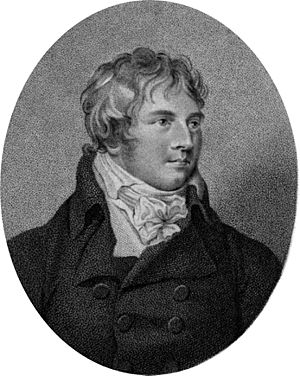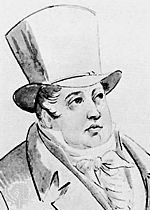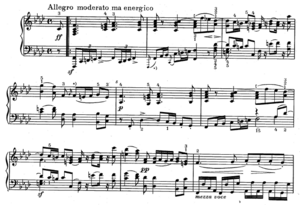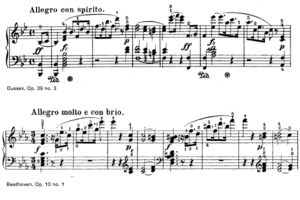Jan Ladislav Dussek facts for kids
Jan Ladislav Dussek (born Jan Václav Dusík; 12 February 1760 – 20 March 1812) was a famous Czech classical composer and pianist. He was a very important musician who shared Czech music with people across Europe in the late 1700s and early 1800s. Some of his piano pieces even sound a bit like Romantic music, which came later.
Dussek was one of the first amazing piano players to travel all over Europe. He played for kings and queens and in big concert halls from London to Saint Petersburg and Milan. People loved his incredible skill on the piano. While he lived in London for almost ten years, he helped make pianos bigger and better. He even got one of the first pianos with a wider range of notes. A writer named Harold Schonberg said Dussek was the first pianist to sit sideways on stage. This way, the audience could see his "handsome face." Many pianists still sit like this today! He was one of Europe's best pianists before Beethoven became famous.
His music often has beautiful, singing melodies. These melodies are sometimes suddenly interrupted by loud and soft parts. Besides his many piano pieces, he also wrote a lot of music for the harp. His harp music is fun to play and sounds lovely. His concertos (pieces for a solo instrument and orchestra) are also very exciting. Many harp players still learn and perform his music today, especially his Sonatas. While not as well-known as some other composers from his time, many music teachers and performers value his piano music. Some even say that Franz Liszt, another famous piano virtuoso, was inspired by Dussek's style.
Contents
Jan Ladislav Dussek's Life Story
Early Life and Family
The Dussek family had a long history of being professional musicians. This musical tradition started with Jan Ladislav's grandfather and continued for many years. Jan Ladislav's mother, Veronika Dusíková, played the harp. Her son later wrote many pieces for both the harp and the piano. His father, Jan Josef, was also a well-known organist and composer. Jan Ladislav's sister, Katerina Veronika Anna Dusíkova, was also a talented musician and composer.
Jan Ladislav was the oldest of three children. He was born on 12 February 1760 in the town of Čáslav in Bohemia. His father taught music and played the organ there. Jan Ladislav started learning piano from his father at age five. By age nine, he was also learning the organ. He had a good singing voice too, so he sang in the church choir.
He continued his music studies at a Jesuit school in Jihlava. There, he studied with the choir director, Ladislav Špinar. His grades were not very good, though! From 1774 to 1776, he studied at another Jesuit school in Kutná Hora. He also played the organ at the Santa Barbara Jesuit church there. In 1776, he went to a school in Prague. Again, he was known for being a bit lazy as a student. He enrolled in the University of Prague in 1777 but only stayed for one semester.
Travels to the Netherlands and Hamburg
After his studies in Bohemia, Dussek started working for Captain Männer, an Austrian military officer, in 1778. Dussek traveled with the Captain to what is now Belgium in 1779. There, he became the organist at the St. Rumbold's Cathedral in Mechelen. In Mechelen, he gave his first public concert, playing his own music. He then traveled to the Dutch Republic. A successful concert in Amsterdam caught the attention of the royal family. He was invited to The Hague, where he taught music to the three children of Stadtholder William V. While in The Hague, he performed for Kaiser Joseph II of Austria, who was very impressed by Dussek's skills.
By 1782, Dussek had left Captain Männer's service and was in Hamburg. He gave a concert there on a "new English fortepiano." While in Hamburg, he might have studied with C. P. E. Bach, a famous composer. He also published his first musical works there. These included three piano concertos and three violin sonatas.
Journeys Through Eastern and Central Europe
From Hamburg, Dussek moved to Saint Petersburg, Russia. He was a favorite musician of Catherine the Great, the Empress of Russia. While there, he met a technician who had created a keyboard version of the glass harmonica. Dussek quickly learned to play this unusual instrument very well. Dussek had to leave Russia quite suddenly. He left just before Catherine's secret police, as he was suspected of being involved in a plot against her. One story says he found a ring on his way to play for Catherine. He put it on, but Catherine recognized it as belonging to someone involved in a plot. This made her suspicious of Dussek.
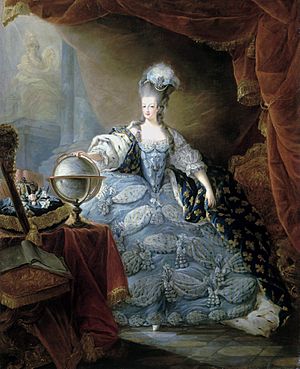
After leaving St. Petersburg, Dussek became the music director for Prince Antoni Radziwiłł in Lithuania. He stayed there for about a year. Some say he left Lithuania because of rumors that he was involved with the Prince's wife. For the next few years, he toured Germany. He was a brilliant performer on both the piano and the glass harmonica. He finally arrived in Paris in 1786. His German tour was a big success. One review said he was admired for his piano playing and his skill on the glass harmonica. Another reviewer wrote that he "entranced all listeners" with his music.
Time in France and Italy
In Paris, Dussek became a favorite of Marie Antoinette, the Queen of France. She tried to convince him not to go on a concert tour to Milan in 1788. However, Dussek wanted to visit his brother Franz in Milan, so he went anyway. His trip to Milan was very successful, and his performances caused "quite a sensation." He returned to Paris and stayed there until just before the Revolution began in 1789. During his time in Paris, he might have met and played music with Napoleon Bonaparte. He also published some violin sonatas dedicated to Eugénie de Beaumarchais, the daughter of a famous writer.
Life in London
Dussek left France for England in May or June 1789 and settled in London. Some stories say he left with the harpist wife of another composer, but this is probably not true. It's also unclear if he left Paris because of the coming revolution or if it was just a coincidence. Early writers often said he left because of the revolution. He had a concert scheduled in London in early June 1789, which would mean he had to leave Paris before the revolution really started.
Dussek made London his home until 1799. By 1790, he was a well-known performer and teacher. He was so popular that people eagerly sought his lessons. He also started working with John Broadwood, a famous piano maker. Dussek received one of Broadwood's first pianos with a wider range of notes. This partnership continued, and in 1794, he received the first piano with an even wider range.
In the spring of 1791, Dussek played in a series of concerts. Many of these concerts featured Sophia, the young daughter of a music publisher. At a concert on 15 June that year, they played a piano duet together. They got married in September 1792. Sophia Corri was a talented singer, pianist, and harpist who became famous herself. They had a daughter named Olivia.
Some of the concerts in 1791 and 1792 featured both Dussek and Joseph Haydn, another very famous composer. Haydn wrote good things about Dussek in a letter to Dussek's father after one of the 1792 concerts. Other important events in 1792 included his marriage to Sophia and starting a music publishing business with Sophia's father. This business was successful at first but struggled later. The problems with the business caused Dussek to leave London in 1799. He left Sophia's father in prison because of debts.
Dussek's business problems did not seem to affect his performing and composing in London. Every year, he played in a series of concerts. Sophia often performed with him, and they frequently played new pieces. Some of his works were so popular that they were repeated at later concerts. One reviewer wrote in 1798 that Dussek's "Military Concerto" was repeated. The reviewer said it was "very deserving of praise." This concerto was even played again the following week!
In 1796, Dussek and his wife started having serious marriage problems. It was said that Sophia, who had fallen in love with another man, asked Dussek for money to fix her harp. She then used the money to leave the house, hiding her belongings in her harp case. She claimed she was going to dinner with a friend. A suspicious Dussek went with his father-in-law to the man's house, where Sophia had locked herself in. She and Dussek argued, and she said mean things to him. Dussek, giving in, promised her freedom to do what she wanted. This led to a kind of reconciliation. It seems unlikely that Dussek ever saw Sophia and his daughter Olivia after he left London in 1799. Sophia had to wait until she knew Dussek had died before she could remarry, which she did in 1812.
Some of Dussek's compositions included arrangements of opera music for piano. He decided to try writing an opera himself in 1798. The result was "The Captive of Spilberg," with words by Prince Hoare. The opera opened at Drury Lane on 14 November 1798. The music was well-received. A critic wrote that Dussek's music was so good that it made him "rank with the first composers of the time."
Business Troubles and Departure
In 1799, the business Dussek had with Corri ran into money problems. It had never been very successful. Dussek and Corri convinced a writer named Lorenzo Da Ponte to lend them money to pay their debts. They failed to pay back this debt. This led to Corri being put in Newgate Prison and caused Dussek to run away. Da Ponte believed that Dussek fled to Paris, but he actually returned to Hamburg. This whole situation ended up causing financial ruin for both Corri and Da Ponte.
Dussek then toured Germany. He became one of the first "glamour" pianists, like Franz Liszt later. According to Louis Spohr, Dussek was the first to turn the piano sideways on stage. This was so "the ladies could admire his handsome profile." Soon after, he started working for Prince Louis Ferdinand of Prussia. The Prince treated him more like a friend and colleague than an employee. When Prince Louis Ferdinand was killed in battle, Dussek wrote a very emotional piano piece called Elégie harmonique.
Later Years and Legacy
In 1807, Dussek returned to Paris. He worked for Talleyrand, a powerful French foreign minister. Dussek became very involved with the piano-making activities of the Érard brothers. He even signed an Érard grand piano from 1808, which can still be seen today. He also gave the first public performance on their new grand piano in 1810. He wrote a powerful piano sonata called Le Retour à Paris (The Return to Paris). This important sonata also got the nickname Plus Ultra. This was a playful response to another composer's piano sonata, which was said to be the most difficult.
Dussek spent the rest of his life performing, teaching, and composing in Prussia and France. He died from gout on 20 March 1812, in Saint-Germain-en-Laye.
Dussek's Musical Style
Dussek was a composer who came before the great Romantic composers for piano, like Chopin, Schumann, and Mendelssohn. Many of his works are quite different from the typical late Classical style of composers like Beethoven and Schubert. The way Dussek's piano music developed shows he had his own unique path. This path hinted at early Romanticism even though it didn't directly influence it.
His most notable works include many large solo piano pieces and piano sonatas. He also wrote many piano concertos and sonatas for violin and piano. He composed a musical play and various chamber music pieces. One unusual piece is a sonata for piano, violin, cello, and percussion. It's called The Naval Battle and Total Defeat of the Dutch by Admiral Duncan (1797). This is a very rare example of early chamber music that includes percussion instruments.
Solo Piano Works
Dussek was one of several composers who helped create a special "London" style of piano music. This was partly because of how pianos were made in England. For example, Joseph Haydn composed his famous E-flat sonata after playing a piano with a wider range that Dussek lent to him. Much of Dussek's piano writing used the richer sounds and wider keyboard range of English pianos. The new possibilities of these instruments helped him create his unique style.
Dussek wrote many solo piano pieces, including 34 Piano Sonatas. He also wrote several pieces that told a story or described something. For example, his The Sufferings of the Queen of France (composed in 1793) tells the story of Marie Antoinette. It includes texts about her sadness at being separated from her children and her final moments before the guillotine.
Along with another composer named Muzio Clementi, Dussek might have inspired Beethoven. Beethoven's own piano works quickly became very popular. Similarities have been noticed between Beethoven's Sonata Opus 10, No. 3 and Dussek's Sonatas Opus 31, No. 2 and Opus 35, No. 2. Also, the beginning of Beethoven's Sonata Opus 10, No. 1 directly uses a part from Dussek's Sonata Opus 39, No. 3.
It's also possible that Dussek influenced Beethoven's famous Sonata Opus 81a, les Adieux. Both the story and the music of Beethoven's piece owed a lot to Dussek's "The Farewell," Opus 44.
Piano Concertos
Dussek composed many piano concertos between 1779 and 1810. Eighteen of these concertos still exist today. Dussek introduced an important new idea to the piano concerto form. Unlike the common classical concerto style, like those by Mozart, Dussek removed the solo part where the performer shows off (called a cadenza) from the first movement in all his concertos written after 1792. Other unique features are also interesting. His Concerto in C major, Op. 29, published in 1795, starts with a slow, serious introduction. This is very unusual for a classical concerto.
His last surviving concerto, Opus 70 in E-flat major, was one of the first to make the opening movement much longer. At 570 measures long, it is about a third longer than his earlier works. This foreshadowed the practice of having a very important and long opening movement in concertos. You can see this in the concertos of Chopin and Johann Nepomuk Hummel, as well as Beethoven's fifth concerto.
Innovations to the Piano
Besides his own music, Dussek is important in music history because of his friendship with John Broadwood. Broadwood was the person who developed the "English Action" piano. Dussek's music needed a stronger sound and a wider range of notes than the pianos of his time could provide. So, he encouraged Broadwood to make several improvements to the instrument's range and sound. It was a Broadwood piano with Dussek's improvements that was sent to Beethoven.
Dussek was also one of the first composers to write instructions for using the piano pedals in his music.
List of Works
Most of Dussek's music involves the piano or harp in some way. He wrote 35 sonatas for solo piano and 11 for piano duets. He also wrote many other pieces for these instruments. His chamber music includes 65 violin sonatas, 24 piano (or harp) trios, and various works for harp, or harp and piano. Some of his sonatas had extra parts added by another composer, J. B. Cramer. His orchestral works were mostly concertos. These included 16 for piano, six for harp, and one for two pianos. He wrote a small number of vocal works, including 12 songs, a cantata, a mass, and one opera, The Captive of Spilberg. His compositions also included arrangements of other works, especially opera openings, for piano.
Cataloging Dussek's compositions has been a challenge. It's been hard to organize his works because many different publishers printed his music. Also, some of his pieces were published by more than one company. Sometimes, different publishers gave the same piece different "opus numbers." And sometimes, different pieces were given the same opus number by different publishers. Dussek made it even more complicated by arranging his works for different combinations of instruments.
The Artaria Company published a list of his works, but it's not complete. Because of this, Howard Craw created a new list in 1964. His works are numbered in the order they were written, with "C" or "Craw" before the number. Works that might not be by him are listed in a separate section with "Craw D" before the number.
Images for kids
See also
 In Spanish: Jan Ladislav Dussek para niños
In Spanish: Jan Ladislav Dussek para niños


